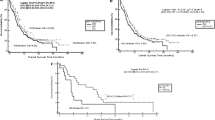Abstract
It has been proposed that genetic factors contribute to the susceptibility of non-small cell lung cancer (NSCLC). The programmed cell death 6 interacting protein (PDCD6IP) encodes for a protein that has been known to bind to the products of the PDCD6 gene, a required protein in apoptosis. The aim of this study is to investigate the relationship between PDCD6IP insertion/deletion (I/D) polymorphism (rs28381975) and NSCLC risk in a Chinese population. A population-based case–control study was conducted in 449 NSCLC patients and 512 cancer-free controls. The genotype of the PDCD6IP gene was determined by using a polymerase chain reaction assay. The promoter activity was analyzed by luciferase reporter assay in A549 and H1299 cells. Statistically significant difference was observed when the patients and controls were compared according to ID + II versus DD (OR = 1.72, 95 % CI 1.29–2.31, P < 0.01). The I allele was significantly associated with NSCLC risk (OR = 1.41, 95 % CI 1.18–1.69, P < 0.01). Compared to TNM stage I + II, PDCD6IP I/D polymorphism significantly increased advanced NSCLC risk (OR = 2.06, 95 % CI 1.30–3.26, P < 0.01). Promoter reporter structures carrying the I allele displayed significantly higher promoter activity than the D allele in A549 and H1299 cells (P = 0.001). The results from this study suggested that PDCD6IP I/D polymorphism was potentially related to NSCLC susceptibility in Chinese Han population.


Similar content being viewed by others
References
Siegel R, Naishadham D, Jemal A. Cancer statistics, 2013. CA Cancer J Clin. 2013;63:11–30.
Rudd MF, Webb EL, Matakidou A, Sellick GS, Williams RD, Bridle H, et al. Variants in the GH-IGF axis confer susceptibility to lung cancer. Genome Res. 2006;16:693–701.
Wang Y, Broderick P, Matakidou A, Eisen T, Houlston RS. Role of 5p15.33 (TERT-CLPTM1L), 6p21.33 and 15q25.1 (CHRNA5-CHRNA3) variation and lung cancer risk in never-smokers. Carcinogenesis. 2010;31:234–8.
Young RP, Hopkins RJ, Whittington CF, Hay BA, Epton MJ, Gamble GD. Individual and cumulative effects of GWAS susceptibility loci in lung cancer: associations after sub-phenotyping for COPD. PLoS One. 2011;6:e16476.
Missotten M, Nichols A, Rieger K, Sadoul R. Alix, a novel mouse protein undergoing calcium-dependent interaction with the apoptosis-linked-gene 2 (ALG-2) protein. Cell Death Differ. 1999;6:124–9.
Vito P, Pellegrini L, Guiet C, D’Adamio L. Cloning of AIP1, a novel protein that associates with the apoptosis-linked gene ALG-2 in a Ca2+-dependent reaction. J Biol Chem. 1999;274:1533–40.
Kerr JF, Wyllie AH, Currie AR. Apoptosis: a basic biological phenomenon with wide-ranging implications in tissue kinetics. Br J Cancer. 1972;26:239–57.
Kerr JF, Winterford CM, Harmon BV. Apoptosis. Its significance in cancer and cancer therapy. Cancer. 1994;73:2013–26.
Kaiser HE, Bodey B. The role of apoptosis in normal ontogenesis and solid human neoplasms. In Vivo. 2000;14:789–803.
Verfaillie T, Garg AD, Agostinis P. Targeting ER stress induced apoptosis and inflammation in cancer. Cancer Lett. 2013;332:249–64.
Wong RS. Apoptosis in cancer: from pathogenesis to treatment. J Exp Clin Cancer Res. 2011;30:87.
Yu Q, Zhou C, Wang J, Chen L, Zheng S, Zhang J. A functional insertion/deletion polymorphism in the promoter of PDCD6IP is associated with the susceptibility of hepatocellular carcinoma in a Chinese population. DNA Cell Biol. 2013;32:451–7.
Zhou C, Luo Q, Qing Y, Lin X, Zhan Y, Ouyang M. Association between MPO 463G>A polymorphism and risk of lung cancer: a meta-analysis. Tumour Biol. 2013;34:3449–55.
Wang L, Chen Z, Wang Y, Chang D, Su L, Guo Y, et al. The association of c.1471G>A genetic polymorphism in XRCC1 gene with lung cancer susceptibility in Chinese Han population. Tumour Biol. 2014.
Liu H, Li HY, Chen HJ, Huang YJ, Zhang S, Wang J. EPHX1 A139G polymorphism and lung cancer risk: a meta-analysis. Tumour Biol. 2013;34:155–63.
Conflicts of interest
None.
Author information
Authors and Affiliations
Corresponding author
Rights and permissions
About this article
Cite this article
Liu, SG., Yuan, Sh., Wu, HY. et al. The programmed cell death 6 interacting protein insertion/deletion polymorphism is associated with non-small cell lung cancer risk in a Chinese Han population. Tumor Biol. 35, 8679–8683 (2014). https://doi.org/10.1007/s13277-014-2081-z
Received:
Accepted:
Published:
Issue Date:
DOI: https://doi.org/10.1007/s13277-014-2081-z




